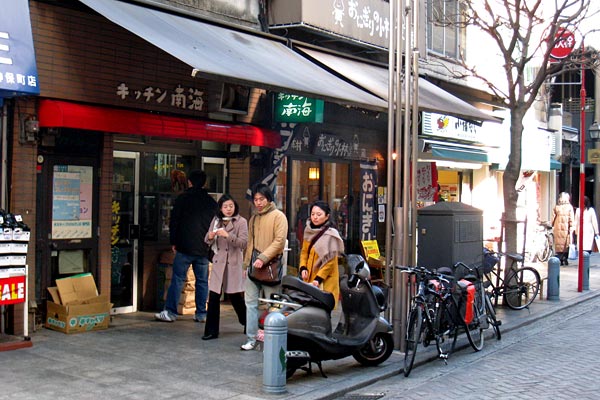- Yummy top
- Eateries and restaurants
- Uoyu - lunch restaurant
- Kanno
- Tokachiya
- Kitchen Nankai - Jinbocho
- Lamb Meat Tender
- Fujiyoshi - tempura restau.
- Enda - Japanese blue crab
- Fukuda - globefish pot
- Sugimoto
- Fuushi
- Soba restaurant
- Shinano - Akabanebashi
- Juwari-soba Inamuraya
- Ando and Korin
- Toranomon Sunaba
- Izakaya
- subLime and Kakinoki
- Donburi-bachi
- Renka
- Yoshida
- Daini-Chikarashuzo
- Sasagin
- Mugiya - soba izakaya
- Fukube
- Sasashin in Ningyo-cho
- Foreign cuisine
- Pizza Piazza
- Atelier de Fromage
- La Piccola Tavola
- Milieu - salad lunch
- Cafe Moskow - Spanish bar
- Sin Tong Kee
- Sekaihanten
- Miscellaneous
- Cheese & champignon party
- Natural Cheese Contest
- Donburi - rice bowl dish
- Home cooking
- Aji no nanban-zuke
- Spaghetti Carbonara
- Curry rice
Kitchen Nankai - Jinbocho
1-5 Kanda-Jinbocho, Chiyoda-ku, 101-0051 TokyoTel: 03-3292-0036
Opening hour: 11:15-16:00, 16:45-20:00 (Mon-Fr)
11:15-20:00 (Sat)
Kitchen Nankai - Jinbocho

A second-hand bookstore in Suzuran-dori.
Since the Edo period (1603-1867) Kanda has been the center of Japan's high level education and research. In the process of modernization of Japan, many universities and high schools were established in Kanda and it became the center of Japanese academic life.
The history of Jinbocho as the center of books started with the opening of the Yuhikaku bookstore in the 1870s. Many others joined the business, and Jinbocho soon became the main center for bookstores, book trading and publication. Students, professors and other intellectuals came to Jinbocho and restaurants and coffee shops opened for them.
Today, the majority of second hand bookstores are located on the south side of Yasukuni-dori (Yasukuni Street). A small street parallel to Yasukuni-dori to the south is called Suzuran-dori (Lily bell Street). In earlier times Suzuran-dori was the main road and has better preserved the intimate atmosphere of the good old days despite modernization. A few alleys south of Suzuran-dori, a huge building was built several years ago and destroyed the cosy neighborhood with small book related businesses and eateries. I regret it, but nobody can go against the flow of time. At least Suzuran-dori is still intact.
- (*)
- Most second hand bookstores in Jinbocho area have their shops facing north, because they don't want their books exposed to the sunshine.

Whenever I go book shopping in Jinbocho, I walk along Suzuran-dori and most probably go into Kitchen Nankai.
Kitchen Nankai is a "yoshoku restaurant" and one of the most popular eateries in the Jinbocho area. Kitchen Nankai is famous for its katsu-karee. The appetizing smell of curry already reaches my nose while I queue up in front of the restaurant. Then, I cannot resist the temptation to eat "katsu-karee" again. A waitress comes out and asks everybody what to eat and I say automatically katsu-karee.
- (*)
- "Yoshoku" means Western-style meal. Their menus are not exactly what exist in European or American countries, but the dishes are inspired by Western meals and modified to the taste of Japanese people. Typical menus are for example curry, croquette, cutlet, gratin and stew. Most yoshoku restaurants are inexpensive.
Karee-raisu (Rice with curry sauce) is one of the yoshoku menus and the Japanese people's favorite dish. Curry sauce was introduced into Japan probably by Chinese or British people and captured the soul of all Japanese people. Katsu of katsu-karee is an abbreviation of ton-katsu, i.e. pork cutlet. Most Japanese men are fond of ton-katsu, while women say ton-katsu is too rich and too heavy in calories. Ton-katu is different from a European style cutlet, as the flour is coarse and the cutlet is deep-fried.

Kitchen Nankai at 13:35. Queue has dissappeared.

Wax-samples in the show window. The dish at the upper left is katsu-karee.

Katsu-karee
Kitchen Nankai has only 9 seats at the counter and 4 tables with 4 seats. As sharing a table is a matter of course, you are not asked whether you mind it. If you are with a friend, you must instead answer a question as to whether you want to sit together. If you say yes, you have to wait a bit longer, until two adjacent seats become vacant. If you go in three or more, it is almost impossible for you to sit together during the busiest lunch time.
Almost as soon as you are seated, a glass of cold water is served and a spoon wrapped with a paper napkin put in front of you. A few minutes later your food is served. Then you should start and finish eating speedily, as many people are standing in a long queue waiting for vacant seats. After several minutes, you finish, pay the bill and leave. The whole process takes about 10 minutes.
Such a system is uncommon even in Japan, maybe except for very popular ramen shops. Some people think that this atmosphere is similar to that of Japanese schools's sports clubs, where students are required to obey militaristic rules and not to waste time.
There are 5 cooks in the restaurant. There is a certain division of labor among them. The first one is specialized in deep-frying. The second one is responsible for pan-frying and cutting of the fried cutlets. The third cook sorts foods and pours curry sauce. The fourth cook prepares materials for other cooks, such as thinly sliced cabbage and mixture of gingered pork slice and vegetables. The last one washes used dishes. The only woman is a waitress. She takes orders and collects money. But, the division of labor is flexible and they help one another when necessary.
During the lunch time, Kitchen Nankai is just like a battle field and the teamwork of the six people is perfect! Staff are working busily and guests are eating in silence.
